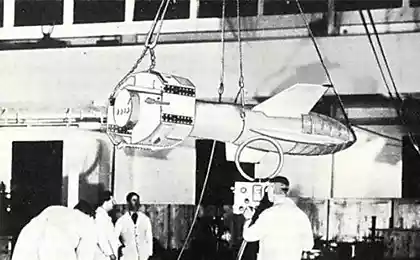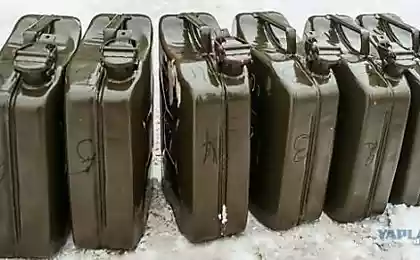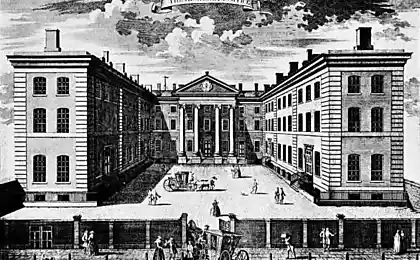1128
How to make equipment (55 photos + text)
The plant is interesting because it has the manufacturing capacity to almost any consumer electronics: televisions, monitors, multimedia players, microwave ovens, vacuum cleaners, etc. And, unlike many assembly plants in Russia, the plant "Televolna" is engaged in the production, ie molds and paints plastic housing, buying electronic components and chips, designing printed circuit boards and electronic modules, releases firmware (firmware), performs all operations soldering - from pure PCB to finished board. All this is completed assembly. Other businesses in Russia, as a rule, are only responsible for the last stage, and all the rest are purchased ready-made in China. Hence, the "sloppy" letters in Russian menu some manufacturers (we will not name them), poor quality of printed circuit boards, flaws and "glitches" firmware, etc.
At the "Televolna" not only organized complete production cycle (from chips and components, raw materials for plastic cases - to finished products), but also runs a multi-stage quality control, which you will learn during our virtual tour. Today, the plant produces home appliances as OEM-manufacturer for well-known companies such as POLAR, Daewoo, Hyundai, etc. Such recognition from international corporations already says a lot.
The plant is placed near the center of the city, and on its territory there are several buildings, as there is still a pre-war times, and built more recently. Of course, this together created and creates considerable difficulties: firstly, the site for the construction of new buildings at the plant almost there, and secondly, to have to put up with not adapted to modern production layout of old buildings.

One of the new buildings of the plant. Click on image to enlarge.

Old building - the former German brewery. It is located at the plant, but belongs to another organization. Click on image to enlarge.
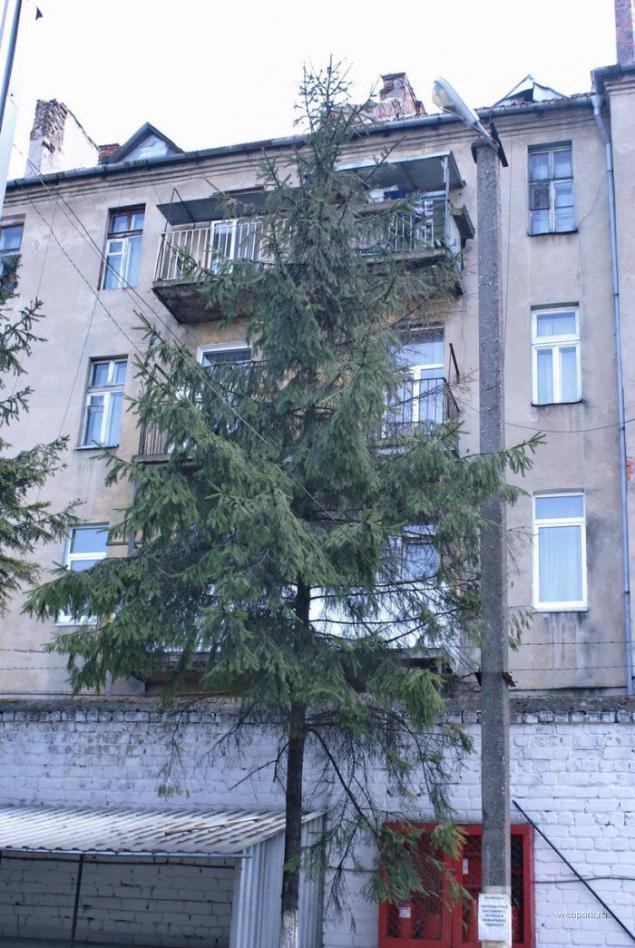
Across the territory of the neat, slim Christmas trees. Click on image to enlarge.
Told us, Igor Yuriev, General Director of "Televolna", the factory concentrates all the technology needed to build "from scratch" any TV, both based on a cathode ray tube (CRT) and LCD panel. By the way, what's interesting, kinescopes in Russia and Lithuania (and previously purchased plant them in this Baltic country) are no longer manufactured, so you have to order them either in Poland (Thomson), or in Malaysia. Since the plant produces mainly low-and middle price segment, today the total volume of the share of LCD TVs is about 10 percent, and CRT televisions small diagonal in Russia is still selling well. Note that the plant is ready to produce a complex and premium high-end equipment, but because it works on the scheme ODM-production, he is forced to carry out the orders of its partners in the plans which this class of equipment takes a very small part.
The plant is equipped with three conveyors that can collect 900 thousand TV sets per year. Moreover, it can be both CRT and LCD TVs in any proportion, conveyor remodeled very quickly. Produced TVs can be equipped with conventional analog tuner and digital, terrestrial or cable broadcasting. According to Igor, digital broadcasting standards MPEG are very flexible, so the plant closely working with digital cable TV operators, creating their systems compatible with firmware versions.
Since the plant produces electronic stuffing yourself, you can produce LCD TV and DVD-player as a chipset performance video processing, and the weak, for different price categories. By the way, just in the autumn planned launch of new models of LCD TVs aimed at the high-end segment, which will be able to compete with the products of well-known manufacturers, as will be equipped with a very powerful digital video processing system. More information we have not yet received, but after six months we hope to conduct tests of new items.
So our virtual tour shows you how to produce modern household appliances. We will guide you from the beginning to the end of production, describing the entire process chain required to produce the finished product.
Virtual Tour
Foundry plastic
First we went to the foundry plastic. Here are produced parts of bodies for TVs and other devices, decorative panels, buttons, etc.

The equipment in the shop completely new.

These injection molding machines can automatically cast the necessary plastic parts.

The mold set in the injection molding machine.

Robot, removing the finished parts.

From this "gun" liquid plastic flows under pressure into the mold. On the circumference seen powerful heating elements.

The shop has more than injection molding machines, the hangar was designed with the stock and can be mounted in the future a few more such facilities. In the meantime, existing more than enough for a full load of the plant. During our visit, the equipment did not work - selling TV has a pronounced seasonality, and hence their production too. Very soon here boils work - to "roast" on demand fall season will need to make a large number of products.
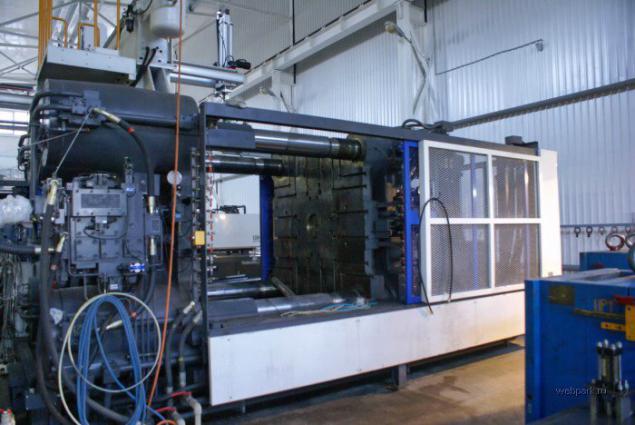
And while there is free time, working on HIV prevention equipment (pictured the failed injection molding machine, its repair).

Check the quality of the molds.
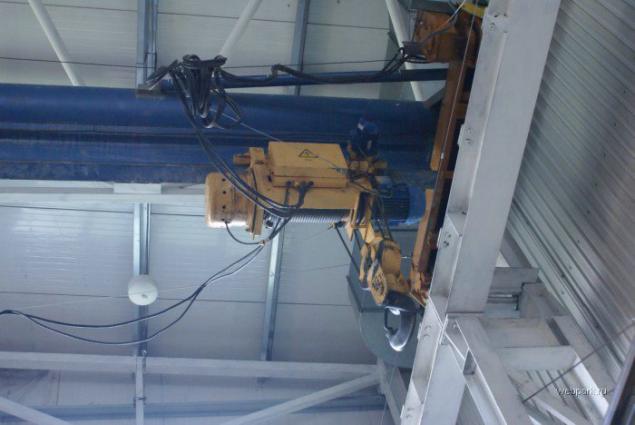
Mold themselves very heavy for their transportation in the shop using the crane.

There is a shop and a small injection molding machines for the production of small parts.

Automated equipment, each machine instruction is glued and safety rules.

Finished parts of bodies wrapped to prevent damage, scratches, and neatly stacked in boxes.

Then parts that require painting, are sent on a conveyor for spraying paint and automatic drying.

Paint shop has a powerful ventilation system. According to Igor, is one of the few shops in the area, past a rigid certification for environmentally friendly production. The work here is not considered harmful.

Ready item after painting and drying.

Here are applied by pad printing and logos.

Traveling from drying parts removed, inspected and, in the absence of marriage, again wrapped and packed into boxes, then sent to the warehouse. Parts ready for assembly.
Shop soldering

In the meantime, you need to prepare the electronic part devices. The plant does not come ready assembled and soldered board in China, but are blank.

On the CNC program laid down on board are set smaller components.

Sequencer glue components of a tape in which they are delivered from the manufacturer, in a tape that is charged into the machine, install them. This allows you to double the productivity of the machine, install the components on the board.
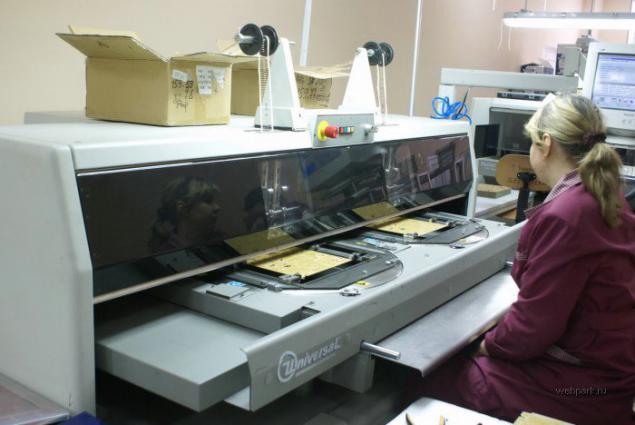

The machine is very fast. It establishes resistors, diodes and jumpers. The ends of the wires on the back side is automatically cut off.
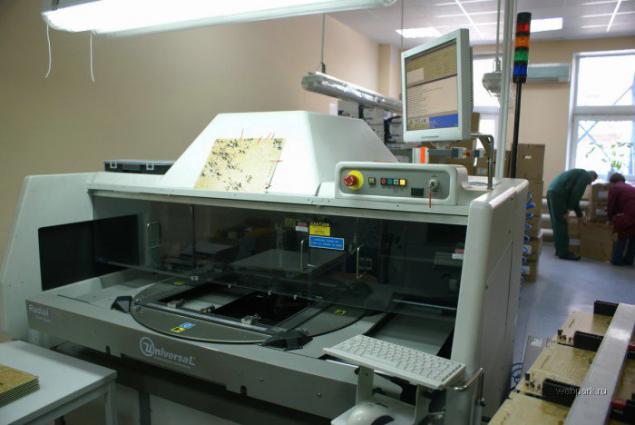
Next machine sets the larger elements.
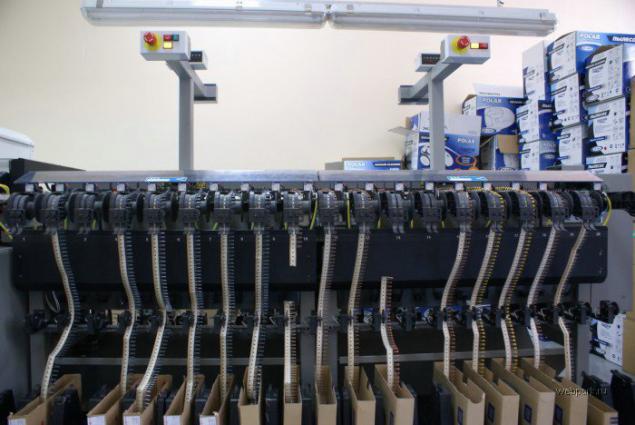
Here are mounted capacitors, transistors, etc.
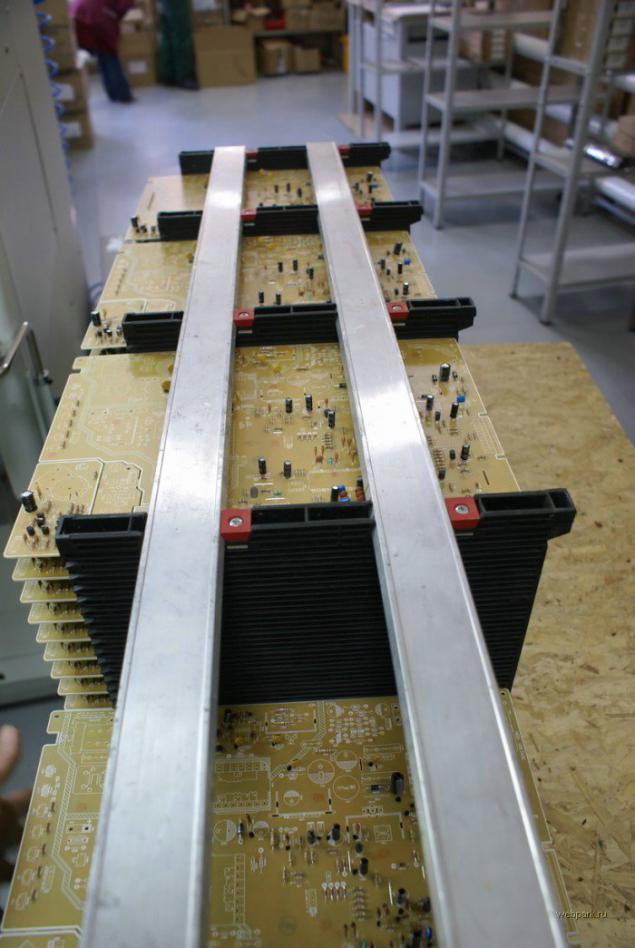
The output is here such fees. The largest elements - transformers, capacious "electrolytes", large chips - set manually, and then, after a visual check, sent to the line of automatic soldering (on the track has already been done flux actually the bottom of the board simply dipped into the molten solder).
This is the last century, you might say. Where miniature SMD-components, multi-layered installation, smart chips? You are right, but think about it - why use expensive components annually lose market CRT TV? Here, technology is unlikely to change, and this is how they produced so far, even the most eminent brands.
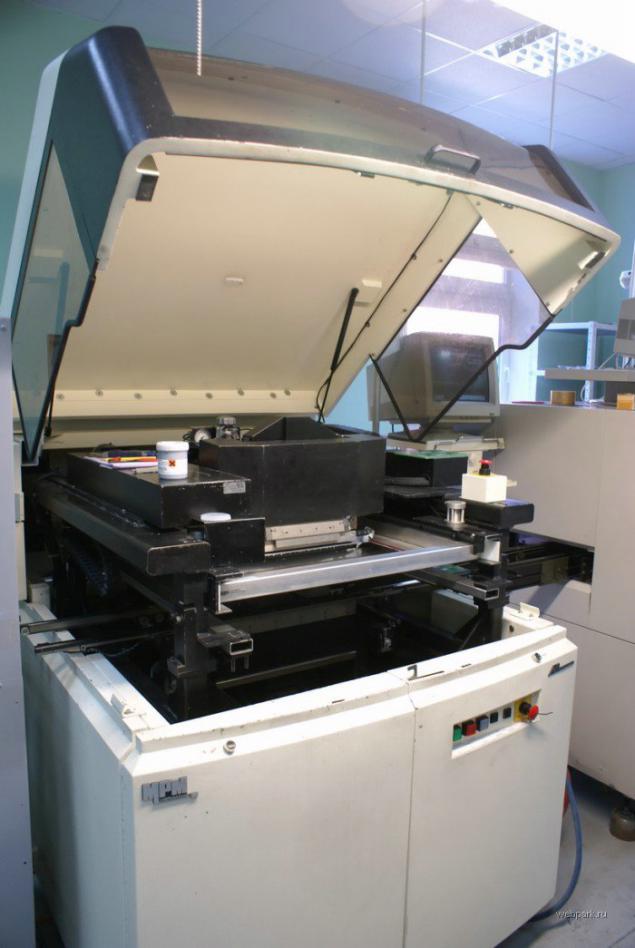
Like new technologies - please. For DVD-players and LCD TVs old is no longer suitable. Here you and miniaturization, and the most modern processors, and more "intelligent" machines. The one in the photo, causing the solder paste on the board - on site for solder. Solder paste consists of flux and solder in suspension and has a very complex composition with a mass of additives. Quality pasta largely ensures the quality of the solder joint. Hence the board will automatically move through the pipeline from machine to machine.

This - Set SMD-components (diodes, capacitors, resistors - the ones you used to see on modern motherboards and graphics cards). In the tapes on reels and just laid in a number of elements. The robot takes the desired program and sets in place the required fee.

Another similar machine.

The robot sets the big chips and chips.

First he takes aim and automatically finds space for a chip.

Takes it out of the container.

And just set it on the board. Robot works very quickly, per board adjusts multiple devices. Then board on the conveyor belt moves on to the next machine.

Then some of the details, such as plastic connectors are installed manually using pnevmopintseta.

The elements are installed and ready for soldering. They hold only until the paste.

Here in a special temperature chart is carried out heating and cooling board with components - so soldering is performed.

Willing to pay double check. If you are not soldered contacts or an excessive amount of solder disadvantage is eliminated here by means of a soldering station. We were told that the defects are rare, but sometimes technology still wrong, and without the help of vigilant employees TCI can not do.
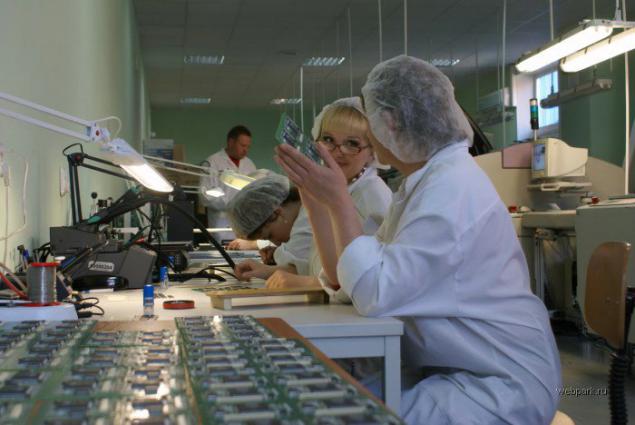
At each stage of the control inspection puts his seal, if successfully passed inspection.

Finished boards are installed in special racks and enter the assembly shop.
Assembly shop

We also visited the shop assembly and testing of electronics for CRT TVs. On the day of our visit, it was empty. Is due to the usual stop in Russia because - at customs "stuck" some important components. Incidentally, the top management of the plant complained to us that, despite the absence of "gray" schemes (and the status of the plant, located in the free economic zone involves strict control and frequent checks on illegal economy here no one even thinks), customs badly mismanaged with their work and often significantly delays the delivery of components. Yet have to put up with this reality.

On registration of some jobs conveyor becomes clear that it employs the weaker sex.
In the next shop work was in full swing at all - was the final assembly and setting a 32-inch LCD TV.

Here is the "heart" of the TV. The boards are also manufactured here in the factory. All electronics are ready for installation, it remains only to mount it in the case and connect the flexible loops.

Something that comes and solder.

Ready TVs mounted on the conveyor and are included. Runs a self-test.

As for dead pixels, they are rare. The reason - use for TV LCD panels category «Grade A», that is of the highest quality. These panels are checked at the factory before packaging, and rejected the party do not get. The truth is they cost a bit more expensive, but now on the line - a product of the middle class.

We were curious, how true statement about the use of high-quality panels - and, indeed, saw the package with LCD panels from Sharp, the quality and characteristics of which we have no doubt. Well, it is commendable.

Of course, pixel defects are found on these panels, but as we were told, is extremely rare. And, more often, it does not prevent the perception of bright white point and, as a rule, single gray pixels that are almost invisible. TVs with apparent defects are removed from the conveyor.

With the help of a special device TVs are adjusted. First exhibited so-called geometry. In fact, the adjusted position of the image on the screen, stage, etc. Setting up automatically for a given program. Control signals are transmitted using the service codes via infrared TV.

TVs that have passed testing and tuning, go to the packaging, and then the finished product warehouse. Well, those items that did not survive the duration of the first turn, or were tests with functional defects are sent to the Department of easy repair.

There products are recovered, defective and defective blocks are replaced with new ones, then the device again sent for testing and tuning.

It employs just 3-4 people, and a small room. And more is not required, because by phase quality control here gets a little product.

In his spare time repairing department staff study circuitry new devices for what we do and caught - in the photo the new TVs.
Conclusion
We went through the whole process chain of production of electronic equipment at the plant "Televolna", was surprised to find that in Russia there is a full production cycle. It is no secret that the majority of domestic manufacturers only buy ready-made electronic modules, body TVs and monitors, and only the "spins screws", or just gets your logo. For plant Chernyahovsk such production means employment of hundreds of people, their education and social protection. "Televolna" pays to the budget reputable tax deductions.
Chernyahovsk plant is, in fact, the main enterprise, because it provides about 800 jobs (from 700 to 1200, depending on the season). This is the largest company in the city, where about 40 thousand people. For their workers and factory provides a good social support. A complete meal, for example, in the canteen costs only 30 rubles.

However, due to the demographic crisis in Russia and the plant has some problems with qualified personnel. So today arranged work at schools and colleges, students are guided tours of the factory. To improve the skills of employees are invited specialists from Moscow, who teach classes on the spot.
Of course, the operation of such an enterprise would be unprofitable, if not a combination of several factors. The main of them - the use of modern equipment is sufficient, the organization of a full production cycle, the low level of wages in the region and, more importantly, work in a free economic zone of the Kaliningrad region. The absence of the latter two advantages in the arsenal of Russian factories located in the central part of the country, making a full-fledged production is simply uneconomical.
Source
At the "Televolna" not only organized complete production cycle (from chips and components, raw materials for plastic cases - to finished products), but also runs a multi-stage quality control, which you will learn during our virtual tour. Today, the plant produces home appliances as OEM-manufacturer for well-known companies such as POLAR, Daewoo, Hyundai, etc. Such recognition from international corporations already says a lot.
The plant is placed near the center of the city, and on its territory there are several buildings, as there is still a pre-war times, and built more recently. Of course, this together created and creates considerable difficulties: firstly, the site for the construction of new buildings at the plant almost there, and secondly, to have to put up with not adapted to modern production layout of old buildings.

One of the new buildings of the plant. Click on image to enlarge.

Old building - the former German brewery. It is located at the plant, but belongs to another organization. Click on image to enlarge.

Across the territory of the neat, slim Christmas trees. Click on image to enlarge.
Told us, Igor Yuriev, General Director of "Televolna", the factory concentrates all the technology needed to build "from scratch" any TV, both based on a cathode ray tube (CRT) and LCD panel. By the way, what's interesting, kinescopes in Russia and Lithuania (and previously purchased plant them in this Baltic country) are no longer manufactured, so you have to order them either in Poland (Thomson), or in Malaysia. Since the plant produces mainly low-and middle price segment, today the total volume of the share of LCD TVs is about 10 percent, and CRT televisions small diagonal in Russia is still selling well. Note that the plant is ready to produce a complex and premium high-end equipment, but because it works on the scheme ODM-production, he is forced to carry out the orders of its partners in the plans which this class of equipment takes a very small part.
The plant is equipped with three conveyors that can collect 900 thousand TV sets per year. Moreover, it can be both CRT and LCD TVs in any proportion, conveyor remodeled very quickly. Produced TVs can be equipped with conventional analog tuner and digital, terrestrial or cable broadcasting. According to Igor, digital broadcasting standards MPEG are very flexible, so the plant closely working with digital cable TV operators, creating their systems compatible with firmware versions.
Since the plant produces electronic stuffing yourself, you can produce LCD TV and DVD-player as a chipset performance video processing, and the weak, for different price categories. By the way, just in the autumn planned launch of new models of LCD TVs aimed at the high-end segment, which will be able to compete with the products of well-known manufacturers, as will be equipped with a very powerful digital video processing system. More information we have not yet received, but after six months we hope to conduct tests of new items.
So our virtual tour shows you how to produce modern household appliances. We will guide you from the beginning to the end of production, describing the entire process chain required to produce the finished product.
Virtual Tour
Foundry plastic
First we went to the foundry plastic. Here are produced parts of bodies for TVs and other devices, decorative panels, buttons, etc.

The equipment in the shop completely new.

These injection molding machines can automatically cast the necessary plastic parts.

The mold set in the injection molding machine.

Robot, removing the finished parts.

From this "gun" liquid plastic flows under pressure into the mold. On the circumference seen powerful heating elements.

The shop has more than injection molding machines, the hangar was designed with the stock and can be mounted in the future a few more such facilities. In the meantime, existing more than enough for a full load of the plant. During our visit, the equipment did not work - selling TV has a pronounced seasonality, and hence their production too. Very soon here boils work - to "roast" on demand fall season will need to make a large number of products.

And while there is free time, working on HIV prevention equipment (pictured the failed injection molding machine, its repair).

Check the quality of the molds.

Mold themselves very heavy for their transportation in the shop using the crane.

There is a shop and a small injection molding machines for the production of small parts.

Automated equipment, each machine instruction is glued and safety rules.

Finished parts of bodies wrapped to prevent damage, scratches, and neatly stacked in boxes.

Then parts that require painting, are sent on a conveyor for spraying paint and automatic drying.

Paint shop has a powerful ventilation system. According to Igor, is one of the few shops in the area, past a rigid certification for environmentally friendly production. The work here is not considered harmful.

Ready item after painting and drying.

Here are applied by pad printing and logos.

Traveling from drying parts removed, inspected and, in the absence of marriage, again wrapped and packed into boxes, then sent to the warehouse. Parts ready for assembly.
Shop soldering

In the meantime, you need to prepare the electronic part devices. The plant does not come ready assembled and soldered board in China, but are blank.

On the CNC program laid down on board are set smaller components.

Sequencer glue components of a tape in which they are delivered from the manufacturer, in a tape that is charged into the machine, install them. This allows you to double the productivity of the machine, install the components on the board.


The machine is very fast. It establishes resistors, diodes and jumpers. The ends of the wires on the back side is automatically cut off.

Next machine sets the larger elements.

Here are mounted capacitors, transistors, etc.

The output is here such fees. The largest elements - transformers, capacious "electrolytes", large chips - set manually, and then, after a visual check, sent to the line of automatic soldering (on the track has already been done flux actually the bottom of the board simply dipped into the molten solder).
This is the last century, you might say. Where miniature SMD-components, multi-layered installation, smart chips? You are right, but think about it - why use expensive components annually lose market CRT TV? Here, technology is unlikely to change, and this is how they produced so far, even the most eminent brands.

Like new technologies - please. For DVD-players and LCD TVs old is no longer suitable. Here you and miniaturization, and the most modern processors, and more "intelligent" machines. The one in the photo, causing the solder paste on the board - on site for solder. Solder paste consists of flux and solder in suspension and has a very complex composition with a mass of additives. Quality pasta largely ensures the quality of the solder joint. Hence the board will automatically move through the pipeline from machine to machine.

This - Set SMD-components (diodes, capacitors, resistors - the ones you used to see on modern motherboards and graphics cards). In the tapes on reels and just laid in a number of elements. The robot takes the desired program and sets in place the required fee.

Another similar machine.

The robot sets the big chips and chips.

First he takes aim and automatically finds space for a chip.

Takes it out of the container.

And just set it on the board. Robot works very quickly, per board adjusts multiple devices. Then board on the conveyor belt moves on to the next machine.

Then some of the details, such as plastic connectors are installed manually using pnevmopintseta.

The elements are installed and ready for soldering. They hold only until the paste.

Here in a special temperature chart is carried out heating and cooling board with components - so soldering is performed.

Willing to pay double check. If you are not soldered contacts or an excessive amount of solder disadvantage is eliminated here by means of a soldering station. We were told that the defects are rare, but sometimes technology still wrong, and without the help of vigilant employees TCI can not do.

At each stage of the control inspection puts his seal, if successfully passed inspection.

Finished boards are installed in special racks and enter the assembly shop.
Assembly shop

We also visited the shop assembly and testing of electronics for CRT TVs. On the day of our visit, it was empty. Is due to the usual stop in Russia because - at customs "stuck" some important components. Incidentally, the top management of the plant complained to us that, despite the absence of "gray" schemes (and the status of the plant, located in the free economic zone involves strict control and frequent checks on illegal economy here no one even thinks), customs badly mismanaged with their work and often significantly delays the delivery of components. Yet have to put up with this reality.

On registration of some jobs conveyor becomes clear that it employs the weaker sex.
In the next shop work was in full swing at all - was the final assembly and setting a 32-inch LCD TV.

Here is the "heart" of the TV. The boards are also manufactured here in the factory. All electronics are ready for installation, it remains only to mount it in the case and connect the flexible loops.

Something that comes and solder.

Ready TVs mounted on the conveyor and are included. Runs a self-test.

As for dead pixels, they are rare. The reason - use for TV LCD panels category «Grade A», that is of the highest quality. These panels are checked at the factory before packaging, and rejected the party do not get. The truth is they cost a bit more expensive, but now on the line - a product of the middle class.

We were curious, how true statement about the use of high-quality panels - and, indeed, saw the package with LCD panels from Sharp, the quality and characteristics of which we have no doubt. Well, it is commendable.

Of course, pixel defects are found on these panels, but as we were told, is extremely rare. And, more often, it does not prevent the perception of bright white point and, as a rule, single gray pixels that are almost invisible. TVs with apparent defects are removed from the conveyor.

With the help of a special device TVs are adjusted. First exhibited so-called geometry. In fact, the adjusted position of the image on the screen, stage, etc. Setting up automatically for a given program. Control signals are transmitted using the service codes via infrared TV.

TVs that have passed testing and tuning, go to the packaging, and then the finished product warehouse. Well, those items that did not survive the duration of the first turn, or were tests with functional defects are sent to the Department of easy repair.

There products are recovered, defective and defective blocks are replaced with new ones, then the device again sent for testing and tuning.

It employs just 3-4 people, and a small room. And more is not required, because by phase quality control here gets a little product.

In his spare time repairing department staff study circuitry new devices for what we do and caught - in the photo the new TVs.
Conclusion
We went through the whole process chain of production of electronic equipment at the plant "Televolna", was surprised to find that in Russia there is a full production cycle. It is no secret that the majority of domestic manufacturers only buy ready-made electronic modules, body TVs and monitors, and only the "spins screws", or just gets your logo. For plant Chernyahovsk such production means employment of hundreds of people, their education and social protection. "Televolna" pays to the budget reputable tax deductions.
Chernyahovsk plant is, in fact, the main enterprise, because it provides about 800 jobs (from 700 to 1200, depending on the season). This is the largest company in the city, where about 40 thousand people. For their workers and factory provides a good social support. A complete meal, for example, in the canteen costs only 30 rubles.

However, due to the demographic crisis in Russia and the plant has some problems with qualified personnel. So today arranged work at schools and colleges, students are guided tours of the factory. To improve the skills of employees are invited specialists from Moscow, who teach classes on the spot.
Of course, the operation of such an enterprise would be unprofitable, if not a combination of several factors. The main of them - the use of modern equipment is sufficient, the organization of a full production cycle, the low level of wages in the region and, more importantly, work in a free economic zone of the Kaliningrad region. The absence of the latter two advantages in the arsenal of Russian factories located in the central part of the country, making a full-fledged production is simply uneconomical.
Source





